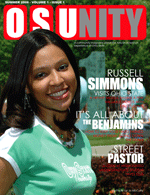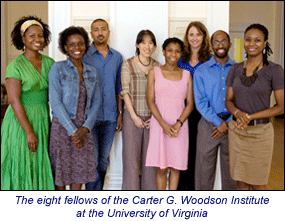How the Election of Barack Obama as President of the United States Will Impact African-American Higher Education
 To most of the nation’s 37 million African Americans, the election of Barack Obama as president of the United States was nothing short of a miracle. But now President-elect Obama has a monumental task ahead of him. He must work to unite the nation, strengthen the economy, fight terrorism, end the war in Iraq, and make tough decisions on healthcare reform, social security, energy development, and a host of other important issues. To most of the nation’s 37 million African Americans, the election of Barack Obama as president of the United States was nothing short of a miracle. But now President-elect Obama has a monumental task ahead of him. He must work to unite the nation, strengthen the economy, fight terrorism, end the war in Iraq, and make tough decisions on healthcare reform, social security, energy development, and a host of other important issues.
But what will the election of Barack Obama mean for African-American higher education?
The mainstay of the Obama plan for higher education is a $4,000 tax credit for all college students. That credit — not a deduction — will cover two thirds of the average cost of tuition at a four-year public college or university. The tax credit would effectively make community college virtually cost-free for students. Under the Obama plan, the tax credit will make funds available for families to pay tuition upfront, not simply reimburse them for tuition expenses when they get their tax refund many months or even a year later.
Low-income students will also have Pell Grants and other financial aid programs to help with the remainder of the cost of attending college. In fact, Obama plans to increase the maximum Pell Grant award to keep pace with inflation and to meet the rising cost of higher education. In past years, the GOP has opposed and essentially blocked any significant increase in Pell Grants for low-income students.
Obama plans to eliminate the complicated application process that students must go through in order to qualify for financial aid. The current Free Application for Federal Financial Aid is five pages long and has over 125 questions. Research has shown that many black and other minority students don’t apply for financial aid because of the difficulty in navigating the process required to obtain aid. In 2004 about 1.5 million students did not apply for a federal Pell Grant even though they were eligible for it.
Obama has proposed a $25 million annual fund to help states develop early assessment programs. These programs are geared toward low-income and minority students so that they can determine if their high school course track is placing them on a path that will qualify them for admission to college.
Obama has also proposed the creation of a community college partnership program. Funds will be made available for programs that will help community college students transfer to four-year colleges after completing their two-year associate’s degrees. Other programs will facilitate the path for community college students to make a smooth transition to the work force.
Unlike the Bush White House, the Obama administration is unlikely to pressure colleges and universities to end race-sensitive admissions programs or race-based scholarships earmarked for black and other minority students. Obama is also likely to appoint federal judges who will look favorably on these programs that are important to African-American college students.
Obama also has a host of proposals that will boost preschool, primary, and secondary education so that black and low-income students will be better prepared for college.

INROADS

Summer Internships
INROADS is the nation’s largest non-profit source of salaried internships for excelling Black, Hispanic/Latino and Native American Indian college students. Students participate in these internships for 2-4 summers during college and earn $10-$25/hr. Most of them receive offers for full-time positions, upon graduation.
We work with the assistance of Educators and Faculty in identifying talent that will benefit from early career development and training for leadership in business, industry and the community at large.
Students who apply for an INROADS Internship are first trained, interviewed, and evaluated. Upon advancement in our process, students are next interviewed by INROADS Corporate Clients, who determine the right fit for the student. Such companies include United Technologies, Deloitte, PricewaterhouseCoopers, MetLife and many others. Upon placement, these students then become INROADS Interns and receive a PAID summer internship, with real-world work, in their major area of study.
INROADS Interns also receive:
• The potential to join the company, full-time upon graduation
• Scholarship information
• A corporate mentor
• Networking events with corporate executives and career-minded peers
• Free tutoring
• Year-round access to an INROADS advisor
Eligible students must:
• Be a U.S. Citizen or Permanent Resident
• Have two or more summers remaining prior to graduation
• Maintain a B or better grade point average (this requirement varies per internship)
• Intend to pursue a career in Business, Engineering, Retail Management, Technology, Health, Marketing or Sales
As you identify students who you feel may benefit from INROADS, please send them to Charles McLean, National Recruiter at cmclean@INROADS.org / (312) 371-3628.
You may also visit our website at www.INROADS.org/recruit/JBHE

New Comic Book Seeks to Teach Black History
 Two teachers in Hampton, Virginia, have produced a 40-page, full-color comic book to teach school students about black contributions to science. The book, entitled The Little Professor & His Friends, features 13 black inventors including Lonnie Johnson, who created the Super-Soaker squirt gun, and George Crum, who made the first potato chip. Two teachers in Hampton, Virginia, have produced a 40-page, full-color comic book to teach school students about black contributions to science. The book, entitled The Little Professor & His Friends, features 13 black inventors including Lonnie Johnson, who created the Super-Soaker squirt gun, and George Crum, who made the first potato chip.
The authors are printing 2,000 copies of the comic book for use in the Hampton Roads school district. They plan to take it to educational conferences around the nation to market the publication nationwide. The book is also for sale online. (click here for more information.)
New Center at Hampton University to Conduct Research on Skin Disease Among African Americans and Other People of Color
 Hampton University, the historically black educational institution in Virginia, has established the Skin of Color Research Institute. The new center will conduct research on skin relating to African Americans, Hispanics, Asians, and Native Americans. Research will focus on skin diseases or disorders common among members of minority groups and in finding cures for these afflictions. Hampton University, the historically black educational institution in Virginia, has established the Skin of Color Research Institute. The new center will conduct research on skin relating to African Americans, Hispanics, Asians, and Native Americans. Research will focus on skin diseases or disorders common among members of minority groups and in finding cures for these afflictions.
The new research center will be housed in a 20,000-square-foot building on the Hampton University campus. Two Hampton faculty members will codirect the institute: David McDaniel, who has more than 30 years of experience as a dermatologist, and Valerie Harvey, a practicing dermatologist who has focused on ethnic skin.
Five Blacks Elected Members of the Institute of Medicine
Although no official data is available by race, JBHE research has shown that blacks have almost no presence among the memberships of the National Academy of Sciences and the National Academy of Engineering.
But the third branch of the National Academies, the Institute of Medicine, appears to have a larger representation of African Americans. Again, while there is no official data by race on the 1,517 members of the Institute of Medicine, JBHE research has found that five of the 65 new inductees to the institute are black.
Here are brief biographies of the five new black members of the Institute of Medicine:
 Lucile L. Adams-Campbell is an epidemiologist who specializes in community health research, interventions, and outreach. She is associate director for minority health and health disparities research at Georgetown University Medical Center in Washington, D.C. Lucile L. Adams-Campbell is an epidemiologist who specializes in community health research, interventions, and outreach. She is associate director for minority health and health disparities research at Georgetown University Medical Center in Washington, D.C.
 Lisa A. Cooper is a professor of medicine at Johns Hopkins University in Baltimore. She is an epidemiologist whose research involves doctor/patient relationships and racial disparities in health. Lisa A. Cooper is a professor of medicine at Johns Hopkins University in Baltimore. She is an epidemiologist whose research involves doctor/patient relationships and racial disparities in health.
 James E.K. Hildreth is the director of the Center for AIDS Health Disparities Research and professor of internal medicine at Meharry Medical College in Nashville. He also is an adjunct professor of pharmacology and molecular sciences at Johns Hopkins. James E.K. Hildreth is the director of the Center for AIDS Health Disparities Research and professor of internal medicine at Meharry Medical College in Nashville. He also is an adjunct professor of pharmacology and molecular sciences at Johns Hopkins.
 Juanita L. Merchant is a professor of internal medicine and molecular and integrative physiology at the University of Michigan. She received her medical training and holds a Ph.D. from Yale University. Juanita L. Merchant is a professor of internal medicine and molecular and integrative physiology at the University of Michigan. She received her medical training and holds a Ph.D. from Yale University.
 Olufunmilayo I. Olopade is the Walter L. Palmer Distinguished Service Professor in Medicine and Human Genetics and founding director of the Center for Clinical Cancer Genetics at the University of Chicago. Olufunmilayo I. Olopade is the Walter L. Palmer Distinguished Service Professor in Medicine and Human Genetics and founding director of the Center for Clinical Cancer Genetics at the University of Chicago.

NEW YORK UNIVERSITY

Postdoctoral and Transition Program for Academic Diversity
The Program
New York University (NYU) is dedicated to ensuring that its scholarly community is ready to compete in a global world and is enriched by individuals, who, through their different races and ethnicities, gender identities, age, abilities, political beliefs, economic status, and sexual orientation, contribute to an intellectually challenging and inclusive educational environment. To that end, NYU has created the NYU Postdoctoral and Transition Program for Academic Diversity fellowship program to support promising scholars and educators from different backgrounds, races, ethnic groups, and other diverse groups whose life experience, research experience, and employment background will contribute significantly to academic excellence at NYU.
Eligibility
The fellowship program is open to all areas of study at the University. U.S. citizens or permanent residents who are from the following three categories may apply:
1) Graduate students in the final year of their dissertation
2) Postdoctoral students who have completed their dissertation within the last three years
3) Professionals transitioning to academic careers (for those in fields for which the doctorate is not the terminal degree)
Awards
NYU will award five in-residence fellowships in 2009. The two-year appointments, which begin September 2009 and end August 2011, have a possibility of a third-year extension. Graduate students in the final year of their dissertation must make significant progress toward the dissertation. Fellows teach a maximum of one course per semester.
Stipends and Allowances
Fellows receive an annual stipend of $40,000 as well as allowances for housing ($20,000), research ($2,000), and one-time relocation ($3,000). The University also provides a medical and dental benefits package.
All materials must be received by JANUARY 15, 2009.
Awards will be announced on MARCH 15, 2009.
The fellowship application and instructions for submission are available at www.nyu.edu/info/provost/2009
New York University is an affirmative action/equal opportunity institution.

Social Psychology Experiment Reveals White College Students’ Reluctance to Discuss Issues of Race
 Researchers at Tufts University and Harvard Business School conducted a series of social psychology experiments to examine if whites avoid talking about race so that they will not be perceived as racist. The results were published in the Journal of Personality and Social Psychology and Developmental Psychology. Researchers at Tufts University and Harvard Business School conducted a series of social psychology experiments to examine if whites avoid talking about race so that they will not be perceived as racist. The results were published in the Journal of Personality and Social Psychology and Developmental Psychology.
In the first experiment a white college student was presented with 30 photographs. People in the pictures were different in race, gender, and appearance. The student was paired with either a black or white partner who chose one of the 30 photographs but hid it from the view of his partner. The white test subject was then told to ask questions of his partner to determine which of the 30 photographs the partner had selected.
Despite the fact that race was an efficient way of narrowing the field to determine which of the 30 photographs was selected, the white test subject was significantly less likely to ask the partner about race if the partner was black than if the partner was white.
A second experiment involved black and white college students who were shown videotapes of the first experiment. Both black and white observers stated that the whites who declined to ask about race were perceived as more prejudiced than those who asked their partner about the race of the person in the photograph. Thus, whites who avoid race in order not to be perceived as racist actually are perceived as more prejudiced than those whites who did not avoid the subject of race.
In a third experiment a similar photographic test was given to elementary school students ages 8 to 11. The students were told that they would score higher if they identified the correct photograph using the least amount of questions. The results showed the students aged 10 and 11 were less likely to ask about race than students who were 8 and 9 even though it caused them to use more questions to arrive at the correct answer.
The authors conclude that children as young as 10 feel the need to try to avoid being perceived as prejudiced.
Appointments
 • Bernice Johnson was named interim provost and vice chancellor for academic affairs at North Carolina Central University. Dr. Johnson, who has taught at the university since 1979, had been serving as dean of the University College. • Bernice Johnson was named interim provost and vice chancellor for academic affairs at North Carolina Central University. Dr. Johnson, who has taught at the university since 1979, had been serving as dean of the University College.
Dr. Johnson holds a master’s degree from Pennsylvania State University and a doctorate from the University of North Carolina at Greensboro.
 • Marshall Shepherd, an associate professor of geography at the University of Georgia, was elected a fellow of the American Meteorological Society. Only two tenths of one percent of society members are elected as fellows. • Marshall Shepherd, an associate professor of geography at the University of Georgia, was elected a fellow of the American Meteorological Society. Only two tenths of one percent of society members are elected as fellows.
 • Abu Karimu Mboka was named assistant professor of criminal justice at California State University Stanislaus. He was on the faculty at Arizona State University, West, in Glendale. • Abu Karimu Mboka was named assistant professor of criminal justice at California State University Stanislaus. He was on the faculty at Arizona State University, West, in Glendale.

UNIVERSITY OF WISCONSIN-STOUT

Integrated Marketing Director
- Bachelor’s degree preferably in the area of communication, marketing, or public relations
- At least ten years of experience in these areas, preferably in higher education
For a full position description, use website:
http://www.uwstout.edu/, click on “Employment at Stout” and then click on Higheredjobs.com
Background check required. EO/AA employer.

Grants
• Bloomfield College in New Jersey received a $600,000 federal grant that will be used to increase the number of black and other minority students studying in the fields of science, technology, engineering, and mathematics.
• Cañada College, a community college in Redwood City, California, received a $1.5 million grant from the U.S. Department of Education. The grant will fund a program to help students in sciences, mathematics, engineering, and technology transfer to four-year institutions. Blacks are 4 percent of the student body at Cañada College.
• Tulane University in New Orleans received a $1.6 million grant from the ExxonMobil Foundation for a program to increase participation in Advanced Placement courses at four predominantly black high schools in New Orleans.
• Fort Valley State University, a historically black educational institution in Georgia, received a $146,947 grant from the National Science Foundation to upgrade its program in entomology.
|
Black Student Graduation Rates Edge Higher But the Large Racial Gap Persists
 The good news is that black student college graduation rates continue to rise. The bad news is that the large racial gap in graduation rates persists. The good news is that black student college graduation rates continue to rise. The bad news is that the large racial gap in graduation rates persists.
New data compiled by the National Collegiate Athletic Association shows that the graduation rate for black students increased one percentage point this year. Now 45 percent of all black students entering four-year colleges earn a diploma at the same institution within six years. For whites, the graduation rate is 64 percent, also up one percentage point from a year ago. Therefore, there remains a huge 19-point gap in graduation rates between black and white college students.
The college graduation rate for black women edged up from 48 percent to 49 percent. Black men also achieved a one percentage point gain. But only 38 percent of black men entering a four-year college go on to earn a bachelor’s degree within six years.
This is the seventh consecutive year in which we have seen a one percentage point increase in the college graduation rate for both black men and black women.

  |
“Putting a college education within reach of every American is the best investment we can make in our future.”
— President-elect Barack Obama
|
New Magazine at Ohio State Is a Recruiting Tool for African-American Students
 The first edition of OSUnity has been published. This 32-page glossy magazine has been developed as a recruiting tool to convince African Americans that Ohio State University has a hospitable environment and is a good academic and social fit for black students. The magazine is being distributed to thousands of prospective black students nationwide. The first edition of OSUnity has been published. This 32-page glossy magazine has been developed as a recruiting tool to convince African Americans that Ohio State University has a hospitable environment and is a good academic and social fit for black students. The magazine is being distributed to thousands of prospective black students nationwide.
The first issue of the magazine profiles black undergraduate students, a black faculty member, and a black graduate student. Other features highlight a visit to the OSU campus by hip-hop mogul Russell Simmons and showcase black fraternities and sororities on campus. Additional articles provide health and finance tips geared toward African-American college students.
Finally, the magazine notes that Ohio State graduates more African Americans than any other university in the Big Ten Conference. All black graduates in the 2007-08 academic year are listed. Information is provided about admissions and other resources for black students on the OSU campus.
Young Black Studies Scholars Thrive at the University of Virginia
The Carter G. Woodson Institute for African-American and African Studies at the University of Virginia has named six new fellows, bringing the total to eight fellows currently at the institute. The fellows are a diverse group of young black studies scholars in the humanities and social sciences who are studying or conducting research for their doctoral thesis or are conducting postdoctoral work. The two-year fellowships offer the individuals an academic environment and all the resources of the University of Virginia to complete their research.
Predoctoral fellows are given an annual stipend of $20,000 and full health insurance coverage. Postdoctoral fellows receive a stipend of $45,000 a year plus benefits. Postdoctoral fellows are required to teach one course per year. Most of the postdoctoral scholars are using the two-year period to expand their dissertation into a book for publication.


NEW YORK UNIVERSITY

Associate Director, Program in Education and Jewish Studies
The Steinhardt School of Culture, Education, and Human Development seeks an individual with scholarly interests and expertise in Jewish Education and Social Studies Education. This position will be jointly appointed between the two disciplinary programs.
Responsibilities: Conduct research in the fields of social studies education and Jewish education; seek external funding; teach courses in social studies education and Jewish education; and advise doctoral and masters students, including those in the new joint masters program in Education and Jewish Studies, co-sponsored by the Skirball Department of Hebrew and Judaic Studies. The successful candidate will also have the opportunity to assist in the activities of The Network for the Teaching of Jewish History, an organization dedicated to improving the teaching of Jewish history through assisting schools and teachers directly in year-long collaborations and through the creation of web-based teaching materials.
Qualifications: Earned doctorate; expertise in the area of social studies education; knowledge of Jewish education in North America and Jewish history; record of or clear potential for a high-quality research program; commitment to excellence in teaching; and a record of teaching in Jewish education or Social Studies at the PreK-12 or collegiate level.
Please send letter of interest, curriculum vitae, and five letters of reference to: Professor Robert Chazan, Department of Teaching and Learning, NYU Steinhardt School of Culture, Education and Human Development, 239 Greene Street, 6th floor, New York, NY 10003-6677. Review of applications will begin immediately and will continue until the search is completed.
NYU is an Equal Opportunity Employer and is committed to building a culturally diverse educational environment.

The Black College President With a Second Full-Time Job
 This fall Kofi Lomotey took over as chancellor of Southern University in Baton Rouge. Dr. Lomotey had been serving as provost and executive vice president at Fisk University in Nashville, Tennessee. This fall Kofi Lomotey took over as chancellor of Southern University in Baton Rouge. Dr. Lomotey had been serving as provost and executive vice president at Fisk University in Nashville, Tennessee.
In addition to the huge array of duties and responsibilities that fall on the president of one of the nation’s largest historically black universities, Dr. Lomotey has decided to continue on as editor of the journal Urban Education. He has served on the editorial board of the journal for the past 21 years, the last 16 years as editor. As editor, Lomotey reads as many as 200 articles each year that are submitted for consideration for publication. The journal is published six times a year.
Dr. Lomotey is a graduate of Oberlin College. He holds a master’s degree from Cleveland State University and a second master’s degree and a doctorate from Stanford University.
New Book to Explore the “Chicago Renaissance”
 Jacqueline Goldsby, associate professor of English language and literature at the University of Chicago, is conducting research on an early twentieth century phenomenon that has had a profound effect on the African-American literary tradition. The period she is examining is not the Harlem Renaissance of the 1920s but rather what she calls the Chicago Renaissance of the 1930s through the 1950s. Jacqueline Goldsby, associate professor of English language and literature at the University of Chicago, is conducting research on an early twentieth century phenomenon that has had a profound effect on the African-American literary tradition. The period she is examining is not the Harlem Renaissance of the 1920s but rather what she calls the Chicago Renaissance of the 1930s through the 1950s.
Professor Goldsby traces the origins of the Chicago Renaissance to Vivian Harsh, the first African American to be named director of a branch of the city’s public library system. Beginning in 1933, Harsh held her weekly Book Review and Lecture Forum at the George Cleveland Hall Branch in the city’s Bronzeville neighborhood. Over the course of the next two decades, thousands of black Americans attended the weekly forums and heard authors and poets such as Richard Wright, Gwendolyn Brooks, Langston Hughes, Margaret Walker, Lorraine Hansberry, and Zora Neale Hurston. At these same forums local African-American writers joined the black literary luminaries of that time to read their own works at the weekly forums.
Professor Goldsby says that these “communal, non-hierarchical, non-elite exchanges represented a decisive break from the East Coast tradition of privatized, enclosed, exclusionary dialogue, particularly within African-American literary societies.”
A graduate of the University of California at Berkeley, Professor Goldsby earned her Ph.D. at Yale University. She has been on the faculty at the University of Chicago since 2000. She is the author of the 2006 book A Spectacular Secret: Lynching in American Life and Literature.
  |
4.8% Percentage of white Americans 12 years or older who are suffering from depression.
8.0% Percentage of African Americans 12 years or older who are suffering from depression.
source: Centers for Disease Control and Prevention
|
In Memoriam
J.L. Chestnut (1930-2008)
J.L. Chestnut, the civil rights lawyer who was the first black attorney in the city of Selma, Alabama, has died of renal failure at a hospital in Birmingham. He was 77 years old.
During the voting rights battles of the mid-1960s, Martin Luther King Jr. and other civil rights leaders relied on the legal skills of Chestnut to fight injunctions against civil rights demonstrations and to keep protesters out of jail.
After the civil rights era, the firm of Chestnut, Sanders, Sanders & Pettaway became the largest black law firm in the state of Alabama. When a white judge warned Chestnut to be respectful of white women on his legal staff, Chestnut told the judge he respected all women “and unlike you, I respect black women.”
More recently, Chestnut was the lead attorney in a class-action lawsuit filed by black farmers against the U.S. Department of Agriculture charging racially discriminatory practices in the awards of farm subsidies. In 2000 Chestnut unsuccessfully defended the black nationalist Jamil Abdullah Al-Amin, formerly H. Rap Brown, on murder charges.
Chestnut was the son of a grocer and elementary school teacher. He graduated from Dillard University in New Orleans and earned his law degree at Howard University in 1958. After graduation from Howard he immediately returned to Alabama and took up what became a half-century-long battle for equal rights.

NORTHWESTERN UNIVERSITY

Tenure-Track & Open Rank Positions in Media, Technology, and Society
The Department of Communication Studies at Northwestern University’s School of Communication seeks to hire three tenure-track appointments beginning September 1, 2009. Two positions will be at the level of assistant professor, and one will be open as to rank.
We are looking for candidates who can work in a strong interdisciplinary program and advance a vital area of research. Possible areas of expertise include but are not limited to: media industries, institutions, publics, and policy; digital media; media and social networks; technology, work, and organizations; computer-mediated communication, human-computer interaction, global media, information infrastructures, and history of communication and information technologies.
The Department of Communication Studies supports a popular undergraduate major and graduate programs in Media, Technology, and Society, Interaction and Social Influence, and Rhetoric and Public Culture. Scholarship includes leading work on new media, technology and society, social networks, and the cultural determination of the public sphere. Through special resources for research support and scholarly event programming, the department is able to offer rich opportunities for scholarly development.
Northwestern University is an equal opportunity, affirmative action educator and employer. Women and minorities are encouraged to apply. Hiring is contingent on eligibility to work in the United States.
Applications should be sent via email to mts-search@northwestern.edu or to Professor Noshir Contractor, Chair, MTS Search Committee, Department of Communication Studies, Northwestern University, 2240 Campus Drive, Evanston, IL 60208-3545. Applications should include a CV, evidence of teaching effectiveness, and three letters of recommendation.
Initial review of applications will begin on October 31, 2008, with continual reviews of subsequently-received applications until all positions are filled or a final review deadline of December 31, 2008 is reached.

Honors and Awards
The University of Pittsburgh’s African-American Alumni Council presented five members of the university community with its Sankofa Award. The award is presented to faculty or administrators who exhibited outstanding educational support and service to students of African descent. Following are this year’s winners:
 • Toi Derricotte is a professor of English and author of four books of poetry. She is a graduate of Wayne State University and holds a master’s degree in English literature and creative writing from New York University. • Toi Derricotte is a professor of English and author of four books of poetry. She is a graduate of Wayne State University and holds a master’s degree in English literature and creative writing from New York University.
• Laurence A. Glasco has taught history at the University of Pittsburgh since 1969. His latest book is The W.P.A. History of the Negro in Pittsburgh. He is a graduate of Antioch College and holds a Ph.D. from the State University of New York at Buffalo.
 • Kathy W. Humphrey is vice provost and dean of students at the university and teaches in the School of Education. She is a graduate of Central Missouri State University. Dr. Humphrey earned a master’s degree at the University of Missouri at Kansas City and a doctorate in educational leadership from Saint Louis University. • Kathy W. Humphrey is vice provost and dean of students at the university and teaches in the School of Education. She is a graduate of Central Missouri State University. Dr. Humphrey earned a master’s degree at the University of Missouri at Kansas City and a doctorate in educational leadership from Saint Louis University.
• Sandra Murray is a professor of cell biology and physiology in the School of Medicine. She has been on the university's faculty for 25 years. Dr. Murray is a graduate of the University of Illinois. She holds a master’s degree in biology from Texas Southern University and a Ph.D. in anatomy from the University of Iowa.
• Betsy A. Porter is director of the Office of Admissions and Financial Aid. She has been an administrator at Pitt since 1978. Porter is a graduate of the University of Charleston. She holds a master’s degree from Duquesne University and an educational doctorate from the University of Pittsburgh.
|
 .
.